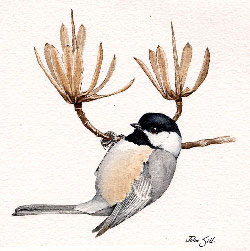Find a Bird - BBA1
Breeding Bird Atlas 1 Species Accounts
Black-capped Chickadee
Parus atricapillus
Egg Dates
April 29 to July 12
Number of Broods
one; may re-lay if first attempt fails.

The Black-capped Chickadee—the Massachusetts state bird—is a permanent resident of the Commonwealth, though on occasion not all individuals remain throughout the year. It was confirmed as a breeder in all sections of the state, inhabiting woodlands, orchards, shade trees, yards, and city parks. In short, the adaptable chickadee will utilize any area with sufficient vegetation for cover and feeding. During the nesting season, it must find woodlands with suitable nest sites, but a birdhouse of the right dimensions will also accommodate it.
Adult Black-capped Chickadees are basically sedentary, but young birds sometimes wander, and, in some years, there may be definite migrations during which some of our breeders depart and the birds from more northerly regions pass through. The numbers involved in these movements vary greatly from year to year. Curiously, after such irruptions, few are noted returning during the following spring, and it is not known with certainty what percentage of these birds return north.
The most familiar vocalizations of this species are chick-a-dee-dee-dee calls of both short and long duration. Another well-known call is a sweet, whistled fee-bee. Though this sound is usually associated with the bonding of pairs, it may be heard at other times as well. Chickadees also produce several short, lisping notes and a rapid chatter when a predator is spotted. Foraging individuals often give a long series of sizzle-ee, sizzle-oo notes.
Spring courting is marked by a burst of agitated activity beginning in late March or April and extending into May. During this season, males actively pursue females. Once a pair bond has been formed, both sexes take part in carving out a cavity in a rotten stump, especially Gray Birch or White Pine. In Bristol County, 75 percent of the nests located were in dead branches or stubs of Gray Birch from 4 to 8 feet above the ground (ACB). Forbush also mentions nests in holes in fence posts, the tops of broken stumps, nest boxes, and cavities in elms as high as 50 feet above the ground. In another sample of 26 Massachusetts nests, 22 were in nest boxes in suburban and rural situations, 2 were in dead Gray Birches, 1 in a dead White Pine, and 1 in a dead snag. The heights ranged from 1 to 10 feet and averaged 5.6 feet, although in nest boxes nest height was determined by the positioning of the boxes (CNR).
The inner material of a stump must be soft and spongy in order to be chipped away and removed with the tiny beak of a chickadee. A week to 10 days may be required to complete the excavating task. When the cavity is ready, the female constructs the actual nest inside, gathering the fibers of Cinnamon Fern, moss, cottony vegetation, hair, insect cocoons, animal fur, and feathers. This work usually takes another 3 or 4 days to complete. The finished structure measures 2 or 3 inches in diameter and 1 inch deep.
Chickadees are generally single brooded, and late nesting records probably represent renesting efforts after an initial failure. The clutch size averages six to eight eggs, although as many as thirteen eggs have been discovered, perhaps the result of 2 females laying in the same nest. For 19 Massachusetts nests, the clutch sizes ranged from two to nine eggs (CNR, DKW). The eggs are dull white, spotted with tiny reddish brown dots. When laying is completed, the female incubates for about 12 days, with the male feeding her during this time.
The nestlings are able to beg and open their beaks when they are 3 days old. At this point, they are covered with a sparse brownish gray down. Both parents feed the young, gathering small caterpillars, other insects, and insect eggs. The young usually fledge in 16 days. Nestling dates for Massachusetts ranged from May 18 to July 24, and fledging dates ranged from June 5 to July 24 (CNR). Family groups with dependent young were observed from early June to August 10 (Meservey).
By the time they fledge, young chickadees resemble the adults, though their plumage is shaggier and appears cleaner. At the end of summer, they undergo a prebasic molt of the contour plumage and wing coverts, at which time they are nearly indistinguishable from adults. Adults undergo a complete molt during July and August, producing a richly colored plumage that is worn all winter. Subsequent wear and fading produces the paler plumage of spring.
The immatures remain in the company of their parents until late summer, moving only a mile or two from the nesting site during the first few months. By fall, the young begin to wander, and the winter flocks no longer consist of family groups. During the post-breeding period, chickadees are joined by a variety of other species, including titmice, woodpeckers, nuthatches, kinglets, brown creepers, and warblers. These mixed-species flocks are very characteristic of Massachusetts woodlands.
During the nonbreeding season, chickadee flocks consist of several pairs plus a variable number of floaters. Each flock maintains a hierarchy, with one pair ranked first, another second, and so on down the line through the floaters. Only the top two pairs get the chance to occupy the group’s range for breeding. If a dominant male or female dies, the highest ranked floater of the right sex takes its place and pairs with the remaining partner. Floaters never pair with floaters; instead, they move from one flock to another in an attempt to raise their social standing. The lowest ranked floater moves up the social scale only if death or replacement removes all higher ranked individuals and a suitable opening occurs (Smith 1991).
Map Legend and Data Summary
Atlas 1 data collected from 1975-1979


Note: common and widespread throughout the state
Helen C. Bates



